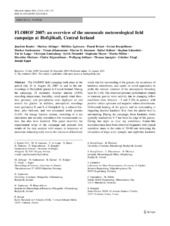FLOHOF 2007: an overview of the mesoscale meteorological field campaign at Hofsjökull, Central Iceland
| dc.contributor.author | Reuder, Joachim | eng |
| dc.contributor.author | Ablinger, Markus | eng |
| dc.contributor.author | Ágústsson, Hálfdán | eng |
| dc.contributor.author | Brisset, Pascal | eng |
| dc.contributor.author | Brynjólfsson, Sveinn | eng |
| dc.contributor.author | Garhammer, Markus | eng |
| dc.contributor.author | Jóhannesson, Tómas | eng |
| dc.contributor.author | Jonassen, Marius O. | eng |
| dc.contributor.author | Kühnel, Rafael | eng |
| dc.contributor.author | Lämmlein, Stephan | eng |
| dc.contributor.author | de Lange, Tor | eng |
| dc.contributor.author | Lindenberg, Christian | eng |
| dc.contributor.author | Malardel, Sylvie | eng |
| dc.contributor.author | Mayer, Stephanie | eng |
| dc.contributor.author | Müller, Martin | eng |
| dc.contributor.author | Ólafsson, Haraldur | eng |
| dc.contributor.author | Rögnvaldsson, Ólafur | eng |
| dc.contributor.author | Schäper, Wolfgang | eng |
| dc.contributor.author | Spengler, Thomas | eng |
| dc.contributor.author | Zängl, Günther | eng |
| dc.contributor.author | Egger, Joseph | eng |
| dc.date.accessioned | 2013-03-21T14:39:05Z | |
| dc.date.available | 2013-03-21T14:39:05Z | |
| dc.date.issued | 2012-04 | eng |
| dc.identifier.issn | 0177-7971 | en_US |
| dc.identifier.issn | 1436-5065 (essn) | en_US |
| dc.identifier.uri | https://hdl.handle.net/1956/6445 | |
| dc.description.abstract | The FLOHOF field campaign took place in the period July 21 to August 24, 2007 on and in the surroundings of Hofsjökull glacier in Central Iceland. During the campaign, 18 automatic weather stations (AWS) recording temperature, humidity, wind speed, wind direction, pressure, and precipitation were deployed on and around the glacier. In addition, atmospheric soundings were performed N and S of Hofsjökull by a tethered balloon, pilot balloons, and two unmanned aerial systems (UAS). An energy balance station, consisting of a net radiometer and an eddy correlation flux measurement station, has also been installed. This paper describes the experimental setup of the campaign and presents first results of the data analysis with respect to transience of mountain-induced gravity waves, the extension of katabatic winds into the surrounding of the glacier, the occurrence of katabatic microfronts, and report on novel approaches to probe the vertical structure of the atmospheric boundary layer by UAS. The observed pressure perturbations related to transient gravity wave activity due to changing inflow conditions were between −2 and 2 hPa in general, with positive values upstream and negative values downstream. Differential heating of the glacier and its surrounding is triggering daytime katabatic flow from the glacier into its surrounding. During the campaign, those katabatic winds typically reached out 4–7 km from the edge of the glacier. During late night in clear sky conditions, frontal-like microstructures have been observed frequently with typical repetition times in the order of 30–60 min indicating the interaction of large-scale synoptic and nighttime katabatic density flows close to the ground. The first research application of the newly developed small unmanned meteorological observer proved the applicability of the system for atmospheric boundary layer research by successfully profiling the atmosphere up to 3.5 km above ground. | en_US |
| dc.language.iso | eng | eng |
| dc.publisher | Springer Vienna | en_US |
| dc.rights | Attribution CC BY | eng |
| dc.rights.uri | http://creativecommons.org/licenses/by/2.0/ | eng |
| dc.title | FLOHOF 2007: an overview of the mesoscale meteorological field campaign at Hofsjökull, Central Iceland | en_US |
| dc.type | Peer reviewed | |
| dc.type | Journal article | |
| dc.description.version | publishedVersion | en_US |
| dc.rights.holder | The Author(s) 2011. This article is published with open access at Springerlink.com | en_US |
| dc.identifier.doi | https://doi.org/10.1007/s00703-010-0118-4 | |
| dc.identifier.cristin | 930685 | |
| dc.source.journal | Meteorology and Atmospheric Physics | |
| dc.source.40 | 116 | |
| dc.source.14 | 1-2 | |
| dc.source.pagenumber | 1-13 |
Files in this item
This item appears in the following Collection(s)
-
Geophysical Institute [1185]

